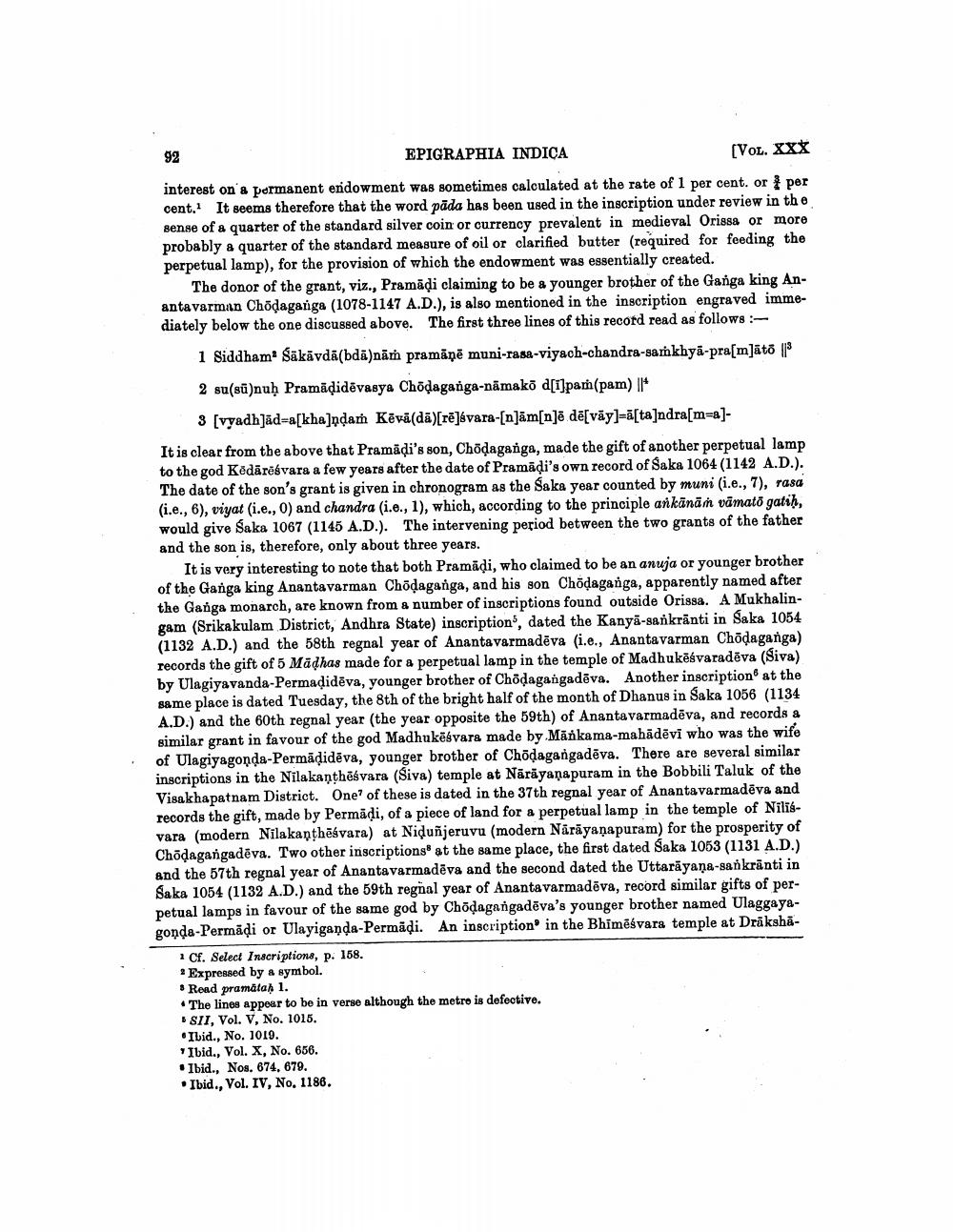________________
EPIGRAPHIA INDICA
(VOL. XXX
interest on a permanent endowment was sometimes calculated at the rate of 1 per cent. or per cent. It seems therefore that the word pada has been used in the inscription under review in the sense of a quarter of the standard silver coin or currency prevalent in medieval Orissa or more probably a quarter of the standard measure of oil or clarified butter (required for feeding the perpetual lamp), for the provision of which the endowment was essentially created.
The donor of the grant, viz., Pramādi claiming to be a younger brother of the Ganga king Anantavarman Chödaganga (1078-1147 A.D.), is also mentioned in the inscription engraved immediately below the one discussed above. The first three lines of this record read as follows:
1 Siddham Sākāvdā(bdā)nāṁ pramāņē muni-rasa-viyach-chandra-samkhya-pra[m]āto 13 2 su(su)nuh Pramādidēvasya Chodaganga-nāmako d[i]pam(pam)
3 [vyadhjād=a[kha]ndar Kēvā(dā)[rē]svara-[n]ām[n]ë dē[vāy)=ā[ta]ndra[m-a)It is clear from the above that Pramāļi's son, Chodaganga, made the gift of another perpetual lamp to the god Kedaresvara a few years after the date of Pramādi's own record of Saka 1064 (1142 A.D.). The date of the son's grant is given in chronogram as the Saka year counted by muni(i.e., 7), rasa (i.e., 6), viyat (i.e., 0) and chandra (i.e., 1), which, according to the principle ankānā vamato gatih, would give Saka 1067 (1145 A.D.). The intervening period between the two grants of the father and the son is, therefore, only about three years.
It is very interesting to note that both Pramādi, who claimed to be an anuja or younger brother of the Ganga king Anantavarman Chōdaganga, and his son Chōdaganga, apparently named after the Ganga monarch, are known from a number of inscriptions found outside Orissa. A Mukhalingam (Srikakulam District, Andhra State) inscription", dated the Kanya-sankranti in Saka 1054 (1132 A.D.) and the 58th regnal year of Anantavarmadēva (i.e., Anantavarman Chōdaganga) records the gift of 5 Mädhas made for a perpetual lamp in the temple of Madhukēsvaradēva (Siva) by Ulagiyavanda-Permadidēva, younger brother of Chodagangadēva. Another inscription at the same place is dated Tuesday, the 8th of the bright half of the month of Dhanus in Saka 1056 (1134 A.D.) and the 60th regnal year (the year opposite the 59th) of Anantavarmadēva, and records & similar grant in favour of the god Madhukësvare made by Māňkama-mahādēvi who was the wife of Ulagiyagonda-Permādidēva, younger brother of Chödagangadēva. There are several similar inscriptions in the Nilakanthēśvara (Siva) temple at Nārāyanapuram in the Bobbili Taluk of the Visakhapatnam District. One of these is dated in the 37th regnal year of Anantavarmadēva and records the gift, made by Permādi, of a piece of land for a perpetual lamp in the temple of Nilisvara (modern Nilakanthēsvara) at Niduñjeruvu (modern Nārāyanapuram) for the prosperity of Chodagangadēva. Two other inscriptions at the same place, the first dated Saka 1063 (1131 A.D.) and the 57th regnal year of Anantavarmadēva and the second dated the Uttarāyana-sankrānti in Saka 1054 (1132 A.D.) and the 59th regnal year of Anantavarmadēva, record similar gifts of perpetual lamps in favour of the same god by Chōdagangadēva's younger brother named Ulaggayagonda-Permādi or Ulayiganda-Permadi. An inscription in the Bhimēsvara temple at Dräksha
1 Cf. Select Inscriptions, p. 158. * Expressed by a symbol. • Read pramata) 1. • The lines appear to be in verse although the metro is defootive.
SII, Vol. V, No. 1015. • Ibid., No. 1019.
Ibid., Vol. X, No. 656. • Ibid., Nos. 674. 679. • Ibid., Vol. IV, No. 1186.




